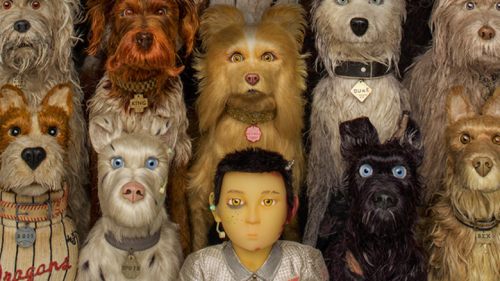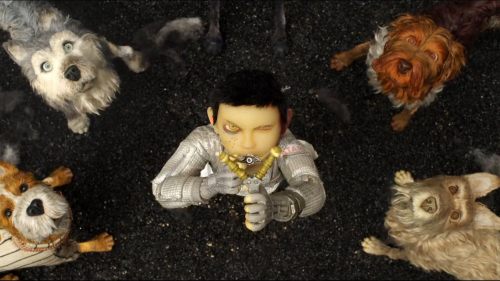ISLE OF DOGS Review: A Love Letter To Man’s Best Friend
It really is a shame that Wes Anderson doesn't do more animation. With his very particular eye toward framing, detail, and composition, Anderson builds worlds that are purposely artificial and plays with wide archetypal strokes to tell stories that are less about particular characters than they are about ideas they inhabit, which translates well to the precision world of animation, especially with the delayed comic timing Anderson injects into his films. Isle of Dogs is only Anderson's second animated film, but unlike Fantastic Mr. Fox's adult-focused take on midlife crises, this entry feels more explicitly targeted at a younger audience. (Don't let that PG-13 rating fool you; other than some instances of the word "bitch" and some darker jokes, there's really nothing objectionable from a violence or vulgarity standpoint.) Consequently, Isle of Dogs feels like a lighter, breezier Wes Anderson than one might expect, but the film is charming in its own right purely by virtue of being a love letter to canine companions.
Twenty years in the future, Japan faces the threat of a dog flu virus spreading through the canine population, to which the mayor of Megasaki (the film's fictional city) responds by decreeing that all dogs must be exiled to Trash Island, separated from humans to prevent the interspecies jump of the disease. Little do the easily-swayed citizens of the city realize, the mayor is willfully ignoring scientific efforts to cure the dog flu out of a generations-long preference for cats. One of the first dogs to be sent to Trash Island is Spots (Liev Schreiber), the bodyguard dog of the mayor's ward and nephew, Atari (Koyu Rankin). Atari resolves to fly a small aircraft to Trash Island, where he encounters a "pack of alpha dogs" (Bryan Cranston, Edward Norton, Bob Balaban, Bill Murray, and Jeff Goldblum), who democratically elect to help Atari find Spots out of respect for the bond Atari has with his lost pup.
Despite a set-up driven entirely by human action, the film places its perspective firmly with the dogs, and much of the film's humor and charm comes from playing with that perspective. Jokes come quickly and without pause for effect, so several beats will pass before it hits you just how absurd some of the dialogue is or how differently dogs view the world with their priorities being placed on loyalty and connection with a human master, even when the human masters have exiled them out of fear. Anderson employs his usual combination of dry wit, camera pans, and precise frame placement to make a charming ode to the unwavering loyalty of man's best friend, and the result is a film built entirely around affection, albeit one that doesn't shy away from actually threatening stakes. Anderson even manages to make the mangy animals inhabiting Trash Island exude lovability from behind matted and spotty fur, turning what should be an ugly locale with ugly residents into a marriage of the undesirable with symmetrical beauty.
But for all that accomplishment, we do have to address the mastiff in the room: the film's portrayal of Japan. Just to be clear, I don't think Anderson or his writing team have any malicious intent toward the Japanese, East Asians, or Asian-Americans; far from it, in fact, as there seems to be a great amount of attention paid to getting details of Japanese culture and traditional ceremony right, though you'll have to forgive this writer for not being an expert in such things. However, Isle of Dogs is built around the narrative conceit that the dog's barks have been rendered into American-accented English – thereby coding them as Western – while the Japanese characters speak in Japanese without subtitles. It's easy to see what the thought process was here: center the empathetic perspective of the primarily English-speaking audience with the dogs, and the humans will come across as alien so as to make their motives more mysterious to our protagonists.
Unfortunately, what the film lacks is a conviction toward adhering to that conceit, as not only are the dogs intelligible to the audience, but Western translators among the Japanese render select portions of the human-sided plot intelligible to the audience, meaning that it's not so much the dogs who we place our empathy with as it is with English-speaking characters who let us in on what's going on. It's a muddied narrative conceit that lacks the conviction to be about dogs struggling to understand humanity and consequently treats the Japanese culture as collateral damage, with translators and a foreign exchange student automatically coded as good guys by virtue of their English communication in contrast to Japanese characters for whom we have to puzzle out their motives. It makes one wonder why the film is even set in Japan if not for that narrative device, so while the film is rich with accurate reference and reverence, it doesn't quite escape treating the Japanese culture as a strange "other" when it clearly should have done so to humanity as a whole.
Does this problematic perspective sink the film? Not for me, but I certainly can't blame anyone for being turned off by yet another Western portrayal of Eastern sensibilities as strange and unrelatable, however unintentional that may be. If you like other Wes Anderson films, or even if you just love dogs, there's going to be a lot here for you to potentially enjoy if the culture clash is something you can put in the back of your mind. This is a funny, endearing bit of stop-motion animation that deserves recognition as another good entry into Anderson's wholly unique oeuvre. I just wish a bit more care had been taken in not making the setting feel like cultural fetishism rather than an integral part of the story.



